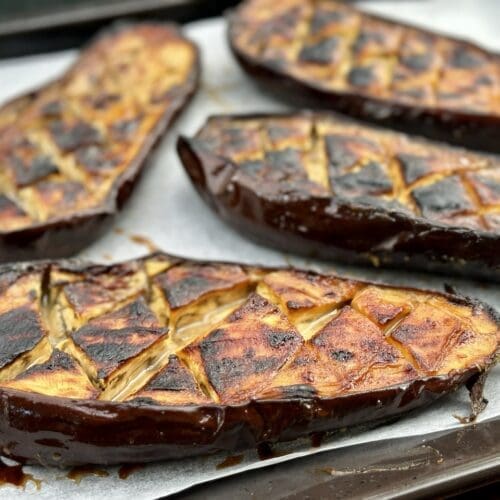
Miso Eggplant with Honey
Gorgeous eggplants roasted with sweet and savoury miso and honey glaze. Don't these Japanese-style Miso Eggplant look tempting?
Video
Ingredients
- 2 eggplants (approx, 500gm / 1.1lb each) (NOTE 1)
- 1 tbsp vegetable oil
HONEY AND MISO GLAZE MIXTURE
- ¼ cup (70gm / 2.5oz) white miso paste or Shiro miso (NOTE 2)
- 2 tbsp honey (or swap for sugar)
- 1 tbsp mirin (NOTE 3)
- 2 tsp cooking sake (NOTE 4)
OPTIONAL GARNISH
- thinly sliced spring onions or scallions
- roasted sesame seeds
Instructions
- Preheat oven to 200°C (390°F) or 180°C (360°F) for fan-forced ovens. Cut the eggplants in half lengthwise and score the flesh with deep cuts close to the skin, being careful not to cut through the skin. To make serving the eggplants easier, cut them diagonally to create a diamond shape. Prepare a large baking tray by lining it with baking or parchment paper. Arrange the eggplants with their flesh side up on the tray and brush them with oil. Bake for 15 minutes.
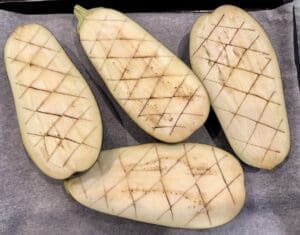
- In the meantime, mix all the ingredients for the honey and miso glaze in a bowl until it's mostly lump free.
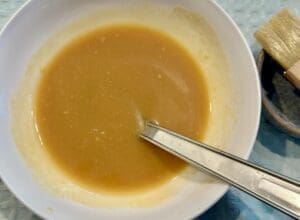
- Brush HALF of the honey and miso glaze mixture over the flesh of the eggplants, then bake for 15 minutes. Baste the eggplants again with the remaining glaze mixture and continue roasting them for another 15 minutes. Grill or broil the eggplants under high heat until they're caramelised and have some char.
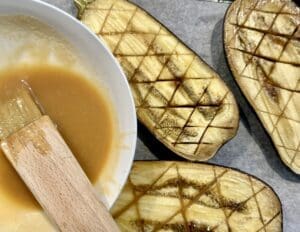
- Optional - Top the eggplants with thinly sliced spring onions and roasted sesame seeds. Serve immediately as the eggplants will become watery if kept too long.
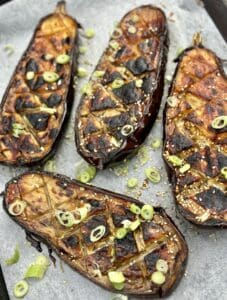
Notes
(NOTE 1) Eggplants (aubergines) - If you find Japanese eggplants, consider yourself lucky as they're sweeter, tender with fewer seeds, which means they're also less bitter. Japanese eggplants are smaller and thinner compared to our typical eggplant. Sadly for us, they're hard to find here, so I used the only ones we have available, the large purple-black common eggplant.
(NOTE 2) White miso (or Shiro miso) is a traditional Japanese condiment created by fermenting soybeans with rice and koji mould. It's slightly sweet and savoury with a creamy texture. White miso is lighter and has a milder taste compared to red or dark miso, but you can use any variety you prefer. You can find miso paste at most supermarkets or Asian grocery stores.
(NOTE 3) Mirin is a sweet Japanese rice wine commonly used in cooking. It has a low alcohol content and has a distinctly sweet taste. You can find mirin at most supermarkets or Asian grocery stores.
(NOTE 4) Cooking sake is a type of Japanese rice wine specifically made for cooking and has a lower alcohol content compared to regular sake. You can find cooking sake at most supermarkets or Asian grocery stores.
I've used a third-party application to calculate the calories and nutritional information, so please use this as an approximate guide only.
Cooking measurements are in Australian standard spoon and cup measurements. For specific details and conversions, visit our Australian Cooking Measurements page.
Nutrition
Serving: 1 ServingCalories: 169kcalCarbohydrates: 30gProtein: 5gFat: 5gSaturated Fat: 1gPolyunsaturated Fat: 3gMonounsaturated Fat: 1gTrans Fat: 0.02gSodium: 691mgPotassium: 615mgFiber: 8gSugar: 20gVitamin A: 73IUVitamin C: 6mgCalcium: 33mgIron: 1mg